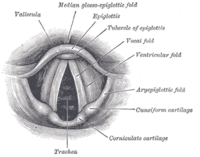
Photo from wikipedia
In hybrid bioprinting of cartilage tissue constructs, spheroids are used as cellular building blocks and combined with biomaterials for dispensing. However, biomaterial intrinsic cues can deeply affect cell fate and… Click to show full abstract
In hybrid bioprinting of cartilage tissue constructs, spheroids are used as cellular building blocks and combined with biomaterials for dispensing. However, biomaterial intrinsic cues can deeply affect cell fate and to date, the influence of hydrogel encapsulation on spheroid viability and phenotype has received limited attention. This study assesses this need and unravels 1) how the phenotype of spheroid-laden constructs can be tuned through adjusting the hydrogel physico-chemical properties and 2) if the spheroid maturation stage prior to encapsulation is a determining factor for the construct phenotype. Articular chondrocyte spheroids with a cartilage specific extracellular matrix (ECM) are generated and different maturation stages, early-, mid-, and late-stage (3, 7, and 14 days, respectively), are harvested and encapsulated in 10, 15, or 20 w/v% methacrylamide-modified gelatin (gelMA) for 14 days. The encapsulation of immature spheroids do not lead to a cartilage-like ECM production but when more mature mid- or late-stage spheroids are combined with a certain concentration of gelMA, a fibrocartilage-like as well as a hyaline cartilage-like phenotype can be induced. As a proof of concept, late-stage spheroids are bioprinted using a 10 w/v% gelMA-Irgacure 2959 solution with the aim to test the processing potential of the spheroid-laden bioink.
Journal Title: Macromolecular bioscience
Year Published: 2021
Link to full text (if available)
Share on Social Media: Sign Up to like & get
recommendations!